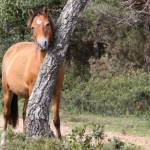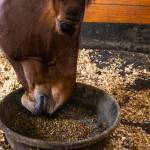Strange Tastes: Pica in Horses

From hair to tree bark to stones, horses with pica seek out and consume unusual substances that have little or no nutritional value.
While traditional lore holds that horses with strange appetites are seeking to make up for a nutritional imbalance, studies have shown that’s not the case. Horses show a true appetite for only three nutrients: energy, salt, and water.
Pica is common in foals, often in the form of coprophagy, the ingestion of feces. This occurs most frequently during the first two months of life and seems to taper off as foals mature. Researchers believe this behavior might play a role in priming the gastrointestinal tract, particularly the hindgut, for bacterial fermentation of forages later in life. Young horses also commonly engage in chewing on the manes and tails of their pasturemates.
Wooden objects, such as fence boards, stalls, and even tree bark, are other frequent targets of curious or bored horses. In many cases, changing the horse’s management to extend the amount of time they spend chewing feedstuffs, such as switching from forage pellets or cubes to long-stem fiber, will reduce or eliminate this behavior.
Mature horses that routinely attempt to ingest foreign objects should be maintained in an area free of unusual consumables to prevent impaction or precipitate the formation of an enterolith, a stone-like mass capable of completely occluding the colon of a horse.
Read more:








